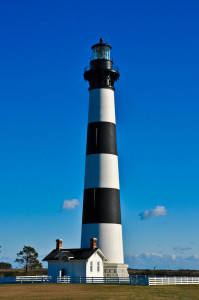Bodie Island Lighthouse on Bodie Island just off NC Highway 12 on the Outer Banks is possessed of a uniquely desolate, yet appealing landscape. Situated on the north side of Oregon Inlet and  bordered by dense pine forests and undergrowth, the lighthouse with its distinctive black horizontal bands was constructed in 1872. It retains the lonely setting to which generations of lighthouse keepers and their families struggled to accommodate. Records show a high rate of turnover of Bodie Island lighthouse personnel, perhaps because of the isolation and the difficulty of getting supplies across Pamlico Sound by boat from Roanoke Island.
bordered by dense pine forests and undergrowth, the lighthouse with its distinctive black horizontal bands was constructed in 1872. It retains the lonely setting to which generations of lighthouse keepers and their families struggled to accommodate. Records show a high rate of turnover of Bodie Island lighthouse personnel, perhaps because of the isolation and the difficulty of getting supplies across Pamlico Sound by boat from Roanoke Island.
Today, of course, the lighthouse’s remote location adds to its appeal to visitors seeking a taste of history and easy access to bird-watching and nature trails. The pond located just to the northeast of the light features a gazebo for bird-watching that’s accessed by a boardwalk allowing visitors to keep dry feet on the way.
Named Bodie Island for the Body family who sold the land to the U. S. Congress for a light station site, the current Lighthouse is the third Bodie Island light. The first two (1847, 1859) were constructed to the south of Oregon Inlet on Pea Island where the first lighthouse tilted due to a faulty foundation and the second was blown up by retreating Confederate troops. Construction of this third edifice was begun in 1871 using work crews, equipment and materials from the recent lighthouse project farther south at Cape Hatteras. Loading docks, dwellings and other facilities were built. Bricks and stone were shipped from Baltimore and ironwork came from a New York foundry. Amazingly, the structure was completed in 1872 and the powerful first-order Fresnel lens, manufactured by the Paris firm of Barbier and Fenestre, was lighted. This powerful dioptric (curved) lens is still in use today, having survived bird strikes and improper grounding during electrical storms in its early days. The power source was converted from oil to electricity in 1932.
In addition to its well preserved setting, the Bodie Island Lighthouse has several intriguing accessory buildings that have been carefully restored and preserved for the public’s enjoyment. There is an attached oil house and workroom, a brick structure that once held whale oil, with a central hallway that leads to the base of the lighthouse tower. The two-story brick double keepers’ quarters is a duplex with each half containing five rooms. Though the light station was altered over the years, the extensive restoration and rehabilitation conducted by the National Park Service in 1990-1992 restored it to its original plan. Rainwater was collected off the roofs of the buildings in three early cisterns, each with a capacity of 2,500 gallons. About seventy-five feet north of the keepers’ quarters is a frame storehouse with a cedar shake side-gable roof. It measure about 24’ X 12’ and rests on brick piers. An original brick walkway connects the lighthouse tower to the rear porch of the keepers’ house. Four granite boundary stones outline the original 15-acre site that has now grown to encompass more than 50 acres.
Planning for a major restoration of the 170-foot lighthouse was begun in 2002, and renovation was carried out between 2009 and 2013, with an interruption by damage from Hurricane Irene. The National Park Service describes Bodie Island Lighthouse as one of only a dozen remaining tall brick tower lighthouses in the United States − and one of the very few with an original first-order Fresnel lens. We on the Outer Banks are fortunate to be able to enjoy and share such a treasure.
